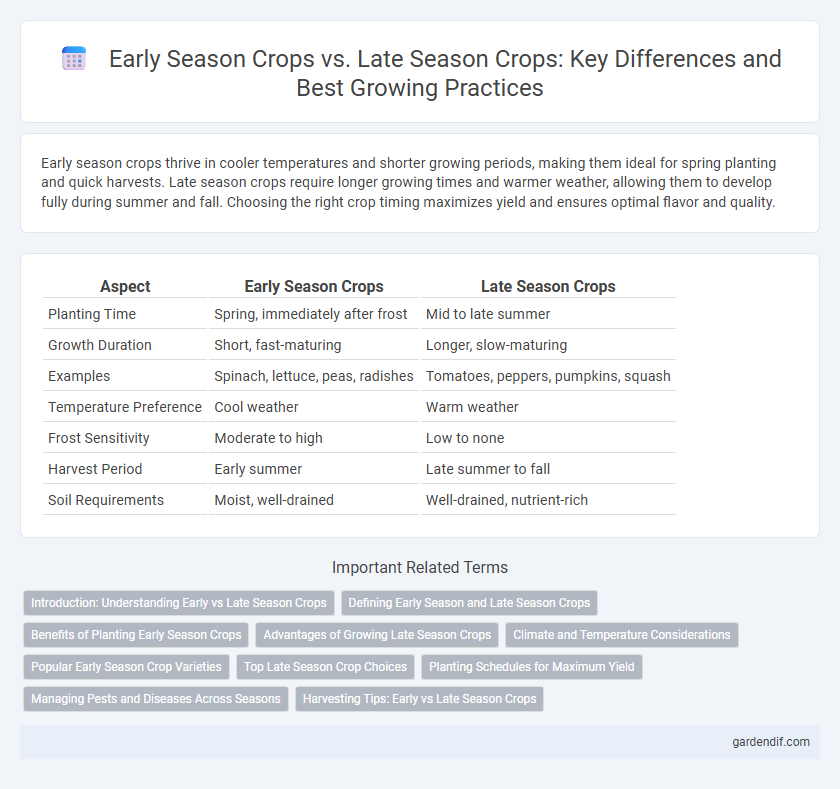
Early season crops vs Late season crops Illustration
Early season crops thrive in cooler temperatures and shorter growing periods, making them ideal for spring planting and quick harvests. Late season crops require longer growing times and warmer weather, allowing them to develop fully during summer and fall. Choosing the right crop timing maximizes yield and ensures optimal flavor and quality.
Table of Comparison
| Aspect | Early Season Crops | Late Season Crops |
|---|---|---|
| Planting Time | Spring, immediately after frost | Mid to late summer |
| Growth Duration | Short, fast-maturing | Longer, slow-maturing |
| Examples | Spinach, lettuce, peas, radishes | Tomatoes, peppers, pumpkins, squash |
| Temperature Preference | Cool weather | Warm weather |
| Frost Sensitivity | Moderate to high | Low to none |
| Harvest Period | Early summer | Late summer to fall |
| Soil Requirements | Moist, well-drained | Well-drained, nutrient-rich |
Introduction: Understanding Early vs Late Season Crops
Early season crops, such as lettuce and radishes, thrive in cooler temperatures and mature quickly, often within 30 to 60 days. Late season crops, including pumpkins and winter squash, require longer growing periods and warmer weather to develop fully, typically harvested after 90 days or more. Recognizing the distinct growth timelines and temperature preferences of these crops is essential for optimizing planting schedules and maximizing yield.
Defining Early Season and Late Season Crops
Early season crops are those planted and harvested at the beginning of the growing season, typically requiring cooler temperatures and shorter maturation periods, such as lettuce, radishes, and spinach. Late season crops develop during the latter part of the growing season, thriving in warmer conditions and longer daylight, examples include tomatoes, pumpkins, and sweet potatoes. Distinguishing between early and late season crops is essential for optimizing planting schedules and maximizing yield in agricultural planning.
Benefits of Planting Early Season Crops
Early season crops benefit from cooler temperatures, reducing the risk of pest infestations and diseases commonly seen in warmer months, leading to healthier plant growth. These crops often mature faster, allowing for multiple harvests within a single growing season and maximizing garden productivity. Early planting also takes advantage of spring moisture, decreasing the need for supplemental irrigation and conserving water resources.
Advantages of Growing Late Season Crops
Late season crops benefit from extended growing periods, allowing for increased biomass accumulation and higher yields. Cooler temperatures and reduced pest pressure in late seasons minimize crop damage, fostering healthier plant development. These crops also enhance soil nutrient retention by utilizing residual soil fertility after early season harvests.
Climate and Temperature Considerations
Early season crops thrive in cooler temperatures and shorter daylight hours, making them ideal for planting in spring when frost risk is still present. Late season crops require warmer temperatures and longer growing periods, often flourishing in summer and early fall when the soil has thoroughly warmed. Understanding local climate patterns and temperature fluctuations is essential for scheduling planting times to maximize yield and reduce crop stress.
Popular Early Season Crop Varieties
Popular early season crop varieties include radishes, lettuce, and spinach, which thrive in cooler temperatures and mature quickly, often within 30 to 45 days. These crops are favored for their ability to provide fresh produce shortly after planting, allowing for multiple harvests within a growing season. Early season varieties typically exhibit strong frost tolerance and rapid germination, making them ideal for spring planting.
Top Late Season Crop Choices
Top late season crop choices include root vegetables like carrots, beets, and sweet potatoes, which thrive in cooler temperatures and extended growing periods. Cruciferous vegetables such as broccoli, Brussels sprouts, and cabbage are also ideal for late season planting due to their frost tolerance. These crops provide hardy, nutrient-dense options that enhance garden yields in fall and early winter harvests.
Planting Schedules for Maximum Yield
Planting schedules for early season crops like lettuce, spinach, and radishes require cooler soil temperatures and shorter growing periods, maximizing yield by capitalizing on the early spring window. Late season crops such as tomatoes, peppers, and squash thrive in warmer conditions and longer daylight, necessitating planting after the last frost date to ensure full maturation. Properly timing crop cycles based on temperature, frost risk, and growth duration optimizes space, prevents overlapping harvests, and significantly boosts total seasonal yield.
Managing Pests and Diseases Across Seasons
Early season crops often face risks from cool-weather pests like aphids and fungal diseases such as downy mildew, requiring vigilant monitoring and targeted treatments to prevent infestations. Late season crops are more susceptible to heat-loving pests like spider mites and diseases such as powdery mildew, demanding adaptive pest management strategies to mitigate damage. Implementing crop rotation and resistant varieties across both seasons enhances pest and disease control for sustainable yield.
Harvesting Tips: Early vs Late Season Crops
Harvesting early season crops requires monitoring for swift maturity to capture peak freshness and nutrient content, often necessitating multiple pickings as crops mature quickly. Late season crops benefit from delayed harvesting, allowing full development of sugars and flavors, with moisture content being a key indicator to prevent spoilage. Proper timing in both cases ensures optimal yield quality and maximizes nutritional benefits.
Early season crops vs Late season crops Infographic

 gardendif.com
gardendif.com